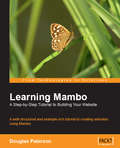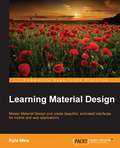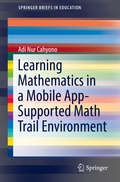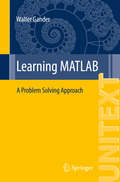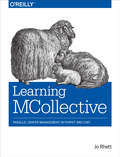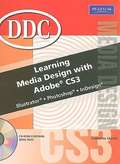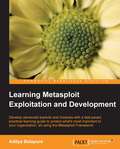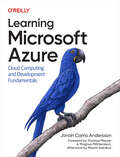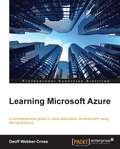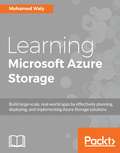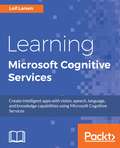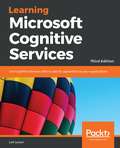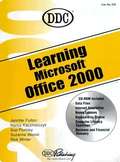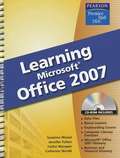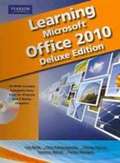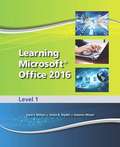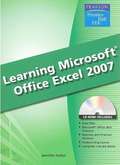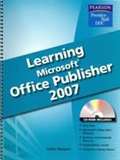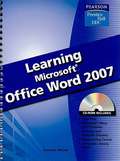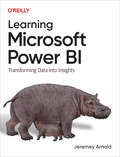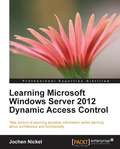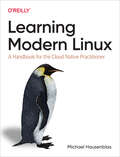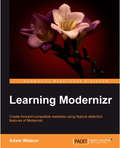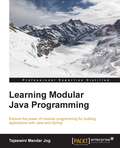- Table View
- List View
Learning Mambo: A Step-by-Step Tutorial to Building Your Website
by Douglas PatersonWritten in a clear, easy-to-read style, the book provides a tutorial for setting up a Mambo website. Each topic is tackled in a practical way with many examples and tasks to develop your skills. A realistic example website is developed incrementally through the book, showing each step in detail. This book is suitable for web developers, designers, webmasters, content editors, and marketing professionals who want develop a fully featured web presence in a simple and straightforward process. No prior knowledge of Mambo is expected, and it does not require any detailed knowledge of programming or web development. Any IT-confident individual will be able to use the book to produce an impressive website.
Learning Material Design
by Kyle MewMaster Material Design and create beautiful, animated interfaces for mobile and web applications About This Book * Master the highly acclaimed Material Design paradigm and give your apps and pages the look that everyone is talking about * Get a mix of key theoretical concepts combined with enough practical examples to put each theory into practice so you can create elegant material interfaces with Android Studio and Polymer * Written by Kyle Mew, successful author with over a decade of mobile and web development experience, this book has both the touch of a developer as well as an experienced writer Who This Book Is For This book is ideal for web developers and designers who are interested in implementing Material Design in their mobile and web apps. No prior knowledge or experience of Material Design is required, but some familiarity with procedural languages such as Java and markup languages such as HTML will provide an advantage. What You Will Learn * Implement Material Design on both mobile and web platforms that work on older handsets and browsers * Design stylish layouts with the Material Theme * Create and manage cards, lists, and grids * Design and implement sliding drawers for seamless navigation * Coordinate components to work together * Animate widgets and create transitions and animation program flow * Use Polymer to bring Material Design to your web pages In Detail Google's Material Design language has taken the web development and design worlds by storm. Now available on many more platforms than Android, Material Design uses color, light, and movements to not only generate beautiful interfaces, but to provide intuitive navigation for the user. Learning Material Design will teach you the fundamental theories of Material Design using code samples to put these theories into practice. Focusing primarily on Android Studio, you'll create mobile interfaces using the most widely used and powerful material components, such as sliding drawers and floating action buttons. Each section will introduce the relevant Java classes and APIs required to implement these components. With the rules regarding structure, layout, iconography, and typography covered, we then move into animation and transition, possibly Material Design's most powerful concept, allowing complex hierarchies to be displayed simply and stylishly. With all the basic technologies and concepts mastered, the book concludes by showing you how these skills can be applied to other platforms, in particular web apps, using the powerful Polymer library. Style and approach Learning Material Design combines the theories behind material design with practical examples of how these can be implemented and further reinforcing the guidelines covering style, layout and structure.
Learning Mathematics in a Mobile App-Supported Math Trail Environment (SpringerBriefs in Education)
by Adi Nur CahyonoThis brief presents the results of a study on the development of the mobile app-supported math trail program for learning mathematics. This study is a part of the MathCityMap-Project, a project of the MATIS I Team from IDMI Goethe-Universität Frankfurt, Germany, that comprises math trails around the city that are supported by the use of GPS-enabled mobile phone technology. The project offers an activity that is designed to support students in constructing their own mathematical knowledge by solving the prepared mathematical tasks on the math trail and interacting with the environment, including the digital environment. The brief focuses specifically on the development of a model for a mobile app-supported math trail programme and the implementation of this programme in Indonesia. It offers both an empirical exploration of its implementation as well as critical assessment of students’ motivation in mathematics, their own performance, as well as teachers’ mathematics beliefs. It concludes with a future-forward perspective by recommending strategies for implementation in schools, among the general public of the existing math trails (including its supporting tool). It also discusses strategies for developing and designing new trails and suggests further research in other geographical regions and contexts for continued project development and implementation. Learning Mathematics in a Mobile App-Supported Math Trail Environment articulates an innovative and exciting future for integrating real mathematical tasks and geographic and digital environment into effective mathematics education.
Learning MATLAB
by Walter GanderThis comprehensive and stimulating introduction to Matlab, a computer language now widely used for technical computing, is based on an introductory course held at Qian Weichang College, Shanghai University, in the fall of 2014. Teaching and learning a substantial programming language aren't always straightforward tasks. Accordingly, this textbook is not meant to cover the whole range of this high-performance technical programming environment, but to motivate first- and second-year undergraduate students in mathematics and computer science to learn Matlab by studying representative problems, developing algorithms and programming them in Matlab. While several topics are taken from the field of scientific computing, the main emphasis is on programming. A wealth of examples are completely discussed and solved, allowing students to learn Matlab by doing: by solving problems, comparing approaches and assessing the proposed solutions.
Learning MCollective
by Jo RhettOrchestrate change across server clusters in near realtime with MCollective, the framework that works in concert with Puppet, Chef, and other configuration management tools. Ideal for system administrators and operations or DevOps engineers at any level, this hands-on guide teaches you how to build and test a real installation of MCollective servers and clients in your environment.Learn how to build an entire installation by hand, know where every configuration file lives, and understand every configuration parameter and what it means. Whether you manage a small environment or one that's immense in scale, this book shows you how to orchestrate specific actions faster and better than you do now.Tour MCollective's architecture, backbone, transport, and security controlsConfigure MCollective components to match your production environmentCreate and use collectives to handle thousands of remote MCollective agentsUse ActiveMQ Network of Brokers to resolve multi-site or redundancy requirementsLearn how to use community-built client and agent plugins, with concrete examplesCreate your own server and client plugins to perform a variety of actionsLearn recommended best practices for using MCollective
Learning MCollective: Parallel Server Management in Puppet and Chef
by Jo RhettOrchestrate change across server clusters in near realtime with MCollective, the framework that works in concert with Puppet, Chef, and other configuration management tools. Ideal for system administrators and operations or DevOps engineers at any level, this hands-on guide teaches you how to build and test a real installation of MCollective servers and clients in your environment.Learn how to build an entire installation by hand, know where every configuration file lives, and understand every configuration parameter and what it means. Whether you manage a small environment or one that’s immense in scale, this book shows you how to orchestrate specific actions faster and better than you do now.Tour MCollective’s architecture, backbone, transport, and security controlsConfigure MCollective components to match your production environmentCreate and use collectives to handle thousands of remote MCollective agentsUse ActiveMQ Network of Brokers to resolve multi-site or redundancy requirementsLearn how to use community-built client and agent plugins, with concrete examplesCreate your own server and client plugins to perform a variety of actionsLearn recommended best practices for using MCollective
Learning Metasploit Exploitation and Development
by Aditya BalapureA practical, hands-on tutorial with step-by-step instructions. The book will follow a smooth and easy-to-follow tutorial approach, covering the essentials and then showing the readers how to write more sophisticated exploits.This book targets exploit developers, vulnerability analysts and researchers, network administrators, and ethical hackers looking to gain advanced knowledge in exploitation development and identifying vulnerabilities. The primary goal is to take readers wishing to get into more advanced exploitation discovery and reaching the next level.Prior experience exploiting basic stack overflows on both Windows and Linux is assumed. Some knowledge of Windows and Linux architecture is expected.
Learning Microsoft Azure
by Jonah Carrio AnderssonIf your organization plans to modernize services and move to the cloud from legacy software or a private cloud on premises, this book is for you. Software developers, solution architects, cloud engineers, and anybody interested in cloud technologies will learn fundamental concepts for cloud computing, migration, transformation, and development using Microsoft Azure.Author and Microsoft MVP Jonah Carrio Andersson guides you through cloud computing concepts and deployment models, the wide range of modern cloud technologies, application development with Azure, team collaboration services, security services, and cloud migration options in Microsoft Azure.You'll gain insight into the Microsoft Azure cloud services that you can apply in different business use cases, software development projects, and modern solutions in the cloud. You'll also become fluent with Azure cloud migration services, serverless computing technologies that help your development team work productively, Azure IoT, and Azure cognitive services that make your application smarter. This book also provides real-world advice and best practices based on the author's own Azure migration experience.Gain insight into which Azure cloud service best suits your company's particular needsUnderstand how to use Azure for different use cases and specific technical requirementsStart developing cloud services, applications, and solutions in the Azure environmentLearn how to migrate existing legacy applications to Microsoft Azure
Learning Microsoft Azure
by Geoff Webber-CrossIf you are a developer interested in building systems for Microsoft Azure, with an understanding of efficient cloud-based application development, then this is the book for you.
Learning Microsoft Azure Storage: Build large-scale, real-world apps by effectively planning, deploying, and implementing Azure storage solutions
by Mohamed WalyA step-by-step guide to get you up and running with Azure Storage services and helps you build solutions that leverage effective design patterns About This Book • Discover best practices for designing and implementing Azure Storage for Azure VMs, and highly available apps • Effectively plan, design, and implement SQL databases with Azure • Protect your data with Azure Backup and Azure Site Recovery Who This Book Is For This book is targeted at Developers, IT Professionals, and even Database Admins who have experience of working on Microsoft Azure and want to make the most of Azure Storage services. Some knowledge of SQL Server will be beneficial. What You Will Learn • Understand Azure Storage types and determine the appropriate one for your needs • Design Azure Storage for Azure VMs according to best practices • Design and implement your SQL Database on Azure according to best practices • Learn how to work with Azure Backup • Learn how to work with Azure Site Recovery • Extend Azure Storage to StorSimple • Monitor storage metrics and logs and customize the Azure monitoring dashboard • Monitor and troubleshoot Azure Storage In Detail Microsoft Azure Storage is the bedrock of Microsoft's core storage solution offering in Azure. No matter what solution you are building for the cloud, you'll find a compelling use for Azure Storage. This book will help you get up-to-speed quickly on Microsoft Azure Storage by teaching you how to use the different storage services. You will be able to leverage secure design patterns based on real-world scenarios and develop a strong storage foundation for Azure virtual machines. You will start this book with an introduction to Microsoft Azure storage and how it can be used to build large-scale, real-world applications using Azure storage services such as blob, table, queue, and file. This book will also teach you about the different types of Azure Storage. You will then find out the best practices for designing your Azure VM storage, whether it is Windows based or Linux based and how to migrate your storage in different scenarios. You will learn also how to plan and implement your SQL database solution on Azure, and how to build your SQL database in different service models (IaaS/PaaS). Moreover, you will also learn best practices for dealing with Azure Backup, the role of Azure Site Recovery, and the solutions they offer in different scenarios. Finally, you will use StorSimple to unlock the maximum value from all of your data, and some tools that will help you manage your storage on-and off-premise (Azure), such as AzCopy and Storage Explorer. Monitoring your storage in no laughing matter, so you will learn to monitor, diagnose and troubleshoot it. Style and approach This book will provide an in-depth insight into properly designing your environment and saving money on your running workloads. Using cutting-edge examples, you will be able to efficiently monitor, diagnose, and troubleshoot Azure Storage.
Learning Microsoft Cognitive Services
by Leif LarsenCreate intelligent apps with vision, speech, language, and knowledge capabilities using Microsoft Cognitive Services About This Book • Explore the capabilities of all 21 APIs released as part of the Cognitive Services platform • Build intelligent apps that combine the power of computer vision, speech recognition, and language processing • Give your apps human-like cognitive intelligence with this hands-on guide Who This Book Is For .NET developers who want to add AI capabilities to their applications will find this book useful. No knowledge of machine learning or AI is expected to follow this book. What You Will Learn • Identify a person through visual inspection and audio • Reduce user effort by utilizing AI-like capabilities • Understand how to analyze images and text in different manners • Find out how to analyze images using Vision APIs • Add video analysis to applications using Vision APIs • Utilize Search to find anything you want • Analyze text to extract information and explore the structure of the text In Detail Microsoft has revamped its Project Oxford to launch the all new Cognitive Services platform—a set of 21 APIs to add speech, vision, language, and knowledge capabilities to apps. This book will introduce you to all 21 APIs released as part of Cognitive Services platform and show you how to leverage their capabilities. More importantly, you'll see how the power of these APIs can be combined to build real-world apps that have cognitive capabilities. The book is split into three sections: computer vision, speech recognition and language processing, and knowledge and search. You will be taken through the vision APIs at first as this is very visual, and not too complex. The next part revolves around speech and language, which are somewhat connected. The last part is about adding real-world intelligence to apps by connecting them to Knowledge and Search APIs. By the end of this book, you will be in a position to understand what Microsoft Cognitive Service can offer and how to use the different APIs. Style and approach This book adopts a step-by-step approach, covering the different APIs with a combination of theory and examples.
Learning Microsoft Cognitive Services: Use Cognitive Services APIs to add AI capabilities to your applications, 3rd Edition
by Leif LarsenBuild smarter applications with AI capabilities using Microsoft Cognitive Services APIs without much hassleKey FeaturesExplore the Cognitive Services APIs for building machine learning applicationsBuild applications with computer vision, speech recognition, and language processing capabilitiesLearn to implement human-like cognitive intelligence for your applicationsBook DescriptionMicrosoft Cognitive Services is a set of APIs for adding intelligence to your application and leverage the power of AI to solve any business problem using the cognitive capabilities.This book will be your practical guide to working with cognitive APIs developed by Microsoft and provided with the Azure platform to developers and businesses. You will learn to integrate the APIs with your applications in Visual Studio. The book introduces you to about 24 APIs including Emotion, Language, Vision, Speech, Knowledge, and Search among others. With the easy-to-follow examples you will be able to develop applications for image processing, speech recognition, text procession, and so on to enhance the capability of your applications to perform more human-like tasks. Going ahead, the book will help you work with the datasets that enable your applications to process various data in form of image, videos, and texts.By the end of the book, you will get confident to explore the Cognitive Services APIs for your applications and make them intelligent for deploying in businesses.What you will learnIdentify a person through visual and audio inspectionReduce user effort by utilizing AI-like capabilitiesUnderstand how to analyze images and texts in different waysAnalyze images using Vision APIsAdd video analysis to applications using Vision APIsUtilize Search to find anything you wantAnalyze text to extract information and explore text structureWho this book is forLearning Microsoft Cognitive Services is for developers and machine learning enthusiasts who want to get started with building intelligent applications without much programming knowledge. Some prior knowledge of .NET and Visual Studio will help you undertake the tasks explained in this book.
Learning Microsoft Office 2000
by Jennifer Fulton Nancy Kaczmarczyk Sue Plumley Suzanne Weixel Rick WinterLearning Microsoft Office 2000 is made up of six chapters: Basics, Word 2000, Excel 2000, Access 2000, PowerPoint 2000 and Challenge Lesson. This book is not merely a reference tool but a hands-on tutorial which offers fast, easy, and self-paced exercises. They walk readers through using all of the new features of Office 2000.
Learning Microsoft Office 2007
by Suzanne Weixel Jennifer Fulton Faithe Wempen Catherine SkintikAre you a visual learner? Do you prefer instructions that show you how to do something - and skip the long-winded explanations? If so, then this book is for you. Open it up, and you will find clear, step-by-step screen shots that show you how to tackle more than 170 Access 2007 tasks. Each task-based spread includes easy, visual directions for performing necessary operations, including * Navigating the new interface * Using templates to create databases * Entering and editing data * Working with tables and fields * Creating simple or summary queries * Linking to Excel(r) worksheets * Helpful sidebars offer practical tips and tricks * Full-color screen shots demonstrate each task * Succinct explanations walk you through step by step * Two-page lessons break big topics into bite-sized modules
Learning Microsoft Office 2010: Deluxe Edition
by Lisa Bucki Chris Katsaropoulos Christy Parrish Suzanne Weixel Faithe WempenThis book covers Word (the word processing tool), Excel (the spreadsheet tool), PowerPoint (the presentation tool), and Access (the database tool). Learning Microsoft Office 2010 Deluxe Edition is made up of five sections.
Learning Microsoft Office 2016 Level 1
by Emergent Learning LLC StaffMicrosoft Office 2016 is Microsoft's suite of application software. The Standard version includes Word, Excel, Outlook, and PowerPoint. Other editions may also include Access, Publisher, OneNote, and InfoPath. This book covers Word (the word processing tool), Excel (the spreadsheet tool), PowerPoint (the presentation tool), and Access (the database tool). Because Microsoft Office is an integrated suite, the components can all be used separately or together to create professional-looking documents and to manage data.
Learning Microsoft Office Excel 2007
by Jennifer FultonKey Benefit:DDC Learning Microsoft Office Excel 2007simplifies the new Office 2007 user interface and powerful new features of Excel. Hands-on exercises and applications provide a practical, effective approach to learning software skills. Key Topics: Covers the features of the application, step-by-step, including expanded coverage of graphics and integration with other Office applications, as well as all Microsoft Certified Application Specialist objectives. Market: For anyone looking to learn MS Office Excel.
Learning Microsoft Power BI: Transforming Data Into Insights
by Jeremey ArnoldMicrosoft Power BI is a data analytics and visualization tool powerful enough for the most demanding data scientists, but accessible enough for everyday use for anyone who needs to get more from data. The market has many books designed to train and equip professional data analysts to use Power BI, but few of them make this tool accessible to anyone who wants to get up to speed on their own.This streamlined intro to Power BI covers all the foundational aspects and features you need to go from "zero to hero" with data and visualizations. Whether you work with large, complex datasets or work in Microsoft Excel, author Jeremey Arnold shows you how to teach yourself Power BI and use it confidently as a regular data analysis and reporting tool.You'll learn how to:Import, manipulate, visualize, and investigate data in Power BIApproach solutions for both self-service and enterprise BIUse Power BI in your organization's business intelligence strategyProduce effective reports and dashboardsCreate environments for sharing reports and managing data access with your teamDetermine the right solution for using Power BI offerings based on size, security, and computational needs
Learning Microsoft Windows Server 2012 Dynamic Access Control
by Jochen NickelThis practical tutorial-based book is filled with information about the architecture, functionality, and extensions of Microsoft Windows Server 2012 Dynamic Access Control.If you are an IT consultant/architect, system engineer, system administrator, or security engineers planning to implement Dynamic Access Control in your organization, or have already implemented it and want to discover more about the abilities and how to use them effectively, this book will be an essential resource. You should have some understanding of security solutions, Active Directory, Access Privileges/ Rights and Authentication methods, and a fundamental understanding of Microsoft technologies. Programming knowledge is not required but can be helpful for using PowerShell or the APIs to customize your solution.
Learning Modern Linux
by Michael HausenblasIf you use Linux in development or operations and need a structured approach to help you dive deeper, this book is for you. Author Michael Hausenblas also provides tips and tricks for improving your workflow with this open source operating system. Whether you're a developer, software architect, or site reliability engineer, this hands-on guide focuses on ways to use Linux for your everyday needs, from development to office-related tasks. Along the way, you'll gain hands-on experience with modern Linux terminals and shells, and learn how to manage your workloads. You'll understand how to run Linux applications by using containers, systemd, modern filesystems, and immutable distros such as Flatcar and Bottlerocket. Use Linux as a modern work environment, rather than just from an admin perspectiveLearn critical components such as the Linux kernel, terminal multiplexer, human-friendly shells, and portable shell scriptingBecome familiar with access control, from file permissions to capabilities, and understand the role of filesystems as a fundamental building blockLearn about application dependency management and containersGain hands-on experience with the Linux networking stack and tooling, including DNSApply modern operating system observability to manage your workloadsBecome familiar with interprocess communication, virtual machines, and selected security topics
Learning Modernizr
by Adam WatsonWritten in an engaging, easy-to-follow style, "Learning HTML5 Modernizr" is a practical guide for using the feature detection features of HTML5 Modernizr to create forward compatible sites. "Learning HTML5 Modernizr" is great for developers looking for a broad range of use cases for feature detection. It is particularly meant for web developers who want to take advantage of the cool new HTML5 and CSS5 features but at the same time deliver a design that is not only backward, but forward compatible.
Learning Modular Java Programming
by Tejaswini Mandar JogExplore the power of modular programming for building applications with Java and Spring! About This Book * Understand the basic concepts of Modular Programming to build enterprise applications with Java * Create short and precise code and eliminate recursion * The book follows a step-by-step approach that makes implementing Modular Programming easy Who This Book Is For This book targets Java developers who have a basic knowledge of application development with Java and are interested in learning the Modular Programming approach for building reusable applications that are easy to test, and thus improve overall project management. What You Will Learn * Learn about Modular Programming and what modules an enterprise application can be divided into. * Set up a development environment and create a "Hello World" application. * Start implementing a sample application from the presentation layer. * Implement the persistence layer. * Implement the business layer, wrapping up all of the modules with Contexts and Dependency Injection (CDI). * Manage an application's life cycle. * Learn how to secure Web applications. * Test enterprise applications and their automation. * Understand how to version source code using Source Code Management (SCM) systems such as GIT and SVN. In Detail Modular programming means dividing an application into small parts and then developing it. It is an approach taken by developers to build applications and helps them add efficiency in their development process, thus making it more effective. The book starts with the fundamentals of Modular Programming. Then we move on to the actual implementation, where we teach developers how to divide an application into different modules or layers (such as presentation, execution, security, lifecycle, services, and so on) for better management. Once readers are well-versed in these modules and their development, the book shows how to create bindings in order to join these different modules and form a complete application. Next, the readers will learn how to manage these modules through dependency injection. Later, we move on to testing; readers will learn how to test the different modules of an application. The book ends by teaching readers how to maintain different versions of their application and how to modify it. By the end of the book, readers will have a good understanding of modular programming and will be able to use it to build applications with Java. Style and approach This book is a practical guide to help readers learn Modular Programming with Java and build an enterprise-ready app along the way. The book is divided into three major sections. The first teaches the fundamentals of Modular Programming and how to implement them; the second teaches readers to combine and manage the modules developed; in the final section, the book explains the applications of Modular Programming.
